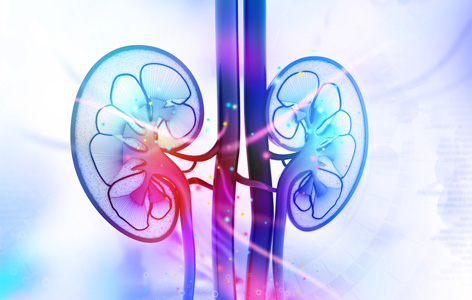Home page Description:
A unique protein profile sampled from urine flags lupus patients with kidney inflammation.
Posted On: February 10, 2017

Image Caption:
Lupus is a leading cause of premature kidney disease. It is difficult to diagnose because symptoms vary—no two cases are exactly alike.
Systemic lupus erythematosus (lupus) is a disorder in which the body’s immune system attacks healthy tissue. This attack results in a range of symptoms including painful joints, rashes and fatigue. Lupus patients sometimes experience kidney inflammation (nephritis), which is one of the major causes of distress and death in people suffering from lupus.
Nephritis can be treated using powerful drugs that suppress the immune system. But these drugs have serious side effects, such as increasing patients’ risk of developing brittle bones and cardiovascular disease. Therefore, knowing exactly who needs treatment is critical.
Diagnosing kidney inflammation currently requires an invasive procedure, where a piece of the patient’s kidney is removed for laboratory analysis. Thus, having an easier way to diagnose nephritis would help clinicians better manage the disorder.
To find a non-invasive marker of nephritis, Krembil Senior Scientist Dr. Joan Wither and her team performed a comprehensive survey of 128 proteins found in the urine, and compared the levels of these proteins in lupus patients with and without active nephritis. The team found 44 proteins that were significantly increased in the urine of lupus patients with kidney inflammation. Ten of these proteins in particular (adiponectin, PAI-1, IL-16, wVF, IP-10, TIMP-1, eotaxin, sgp130, HGF, and PDGF-BB) were elevated in patients whose biopsies indicated that they required more aggressive treatment for kidney inflammation.
“We have identified a novel cluster of proteins that discriminate between lupus patients with and without nephritis. Many of these proteins return to normal levels when patients are in remission,” says Dr. Wither. “Therefore, measuring these urinary proteins has potential clinical utility for identifying which patients require therapy and monitoring treatment response—without requiring a renal biopsy.”
This work was supported by the Canadian Institutes of Health Research, the Alliance for Lupus Research, the Arthritis and Autoimmunity Research Centre of the University Health Network, The Arthritis Society, the Arthritis Centre of Excellence, University of Toronto and the Toronto General & Western Hospital Foundation. PR Fortin is a Tier 1 Canada Research Chair in Systemic Autoimmune Rheumatic Diseases.
Landolt-Marticorena C, Prokopec SD, Morrison S, Noamani B, Bonilla D, Reich H, Scholey J, Avila-Casado C, Fortin PR, Boutros PC, Wither J. A discrete cluster of urinary biomarkers discriminates between active systemic lupus erythematosus patients with and without glomerulonephritis. Arthritis Res Ther. 2016 Oct 4. doi: 10.1186/s13075-016-1120-0.
Nephritis can be treated using powerful drugs that suppress the immune system. But these drugs have serious side effects, such as increasing patients’ risk of developing brittle bones and cardiovascular disease. Therefore, knowing exactly who needs treatment is critical.
Diagnosing kidney inflammation currently requires an invasive procedure, where a piece of the patient’s kidney is removed for laboratory analysis. Thus, having an easier way to diagnose nephritis would help clinicians better manage the disorder.
To find a non-invasive marker of nephritis, Krembil Senior Scientist Dr. Joan Wither and her team performed a comprehensive survey of 128 proteins found in the urine, and compared the levels of these proteins in lupus patients with and without active nephritis. The team found 44 proteins that were significantly increased in the urine of lupus patients with kidney inflammation. Ten of these proteins in particular (adiponectin, PAI-1, IL-16, wVF, IP-10, TIMP-1, eotaxin, sgp130, HGF, and PDGF-BB) were elevated in patients whose biopsies indicated that they required more aggressive treatment for kidney inflammation.
“We have identified a novel cluster of proteins that discriminate between lupus patients with and without nephritis. Many of these proteins return to normal levels when patients are in remission,” says Dr. Wither. “Therefore, measuring these urinary proteins has potential clinical utility for identifying which patients require therapy and monitoring treatment response—without requiring a renal biopsy.”
This work was supported by the Canadian Institutes of Health Research, the Alliance for Lupus Research, the Arthritis and Autoimmunity Research Centre of the University Health Network, The Arthritis Society, the Arthritis Centre of Excellence, University of Toronto and the Toronto General & Western Hospital Foundation. PR Fortin is a Tier 1 Canada Research Chair in Systemic Autoimmune Rheumatic Diseases.
Landolt-Marticorena C, Prokopec SD, Morrison S, Noamani B, Bonilla D, Reich H, Scholey J, Avila-Casado C, Fortin PR, Boutros PC, Wither J. A discrete cluster of urinary biomarkers discriminates between active systemic lupus erythematosus patients with and without glomerulonephritis. Arthritis Res Ther. 2016 Oct 4. doi: 10.1186/s13075-016-1120-0.

